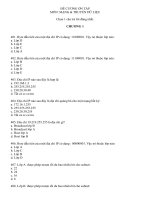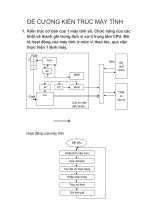Đề cương kiến trúc mạng 1
Bạn đang xem bản rút gọn của tài liệu. Xem và tải ngay bản đầy đủ của tài liệu tại đây (107.53 KB, 6 trang )
ĐỀ CƯƠNG KIẾN TRÚC MẠNG 1
(Network Infrastructure)
1. Mã môn học: 3101012055
2. Số đơn vị học trình: 4
3. Trình độ thuộc khối kiến thức:
4. Phân bố thời gian: 30LT+60TH
5. Điều kiện tiên quyết:
6. Mô tả vắn tắt môn học:
Môn học này cung cấp các khái niệm và loại dịch vụ mạng, các tài nguyên và các thông số
mạng cơ bản Ngoài ra, môn học này còn nhằm cung cấp cho sinh viên các kỹ năng và kiến
thức để cấu hình, quản lý và giải quyết các sự cố về mạng.
7. Nhiệm vụ của sinh viên:
- Dự lớp: 80%
- Bài tập: Làm bài tập tại lớp và bài tập về nhà
- Dụng cụ học tập: Lý thuyết: Projector, Thực hành: Phòng mạng, máy ảo cài Vmware
- Khác: Không
8. Tài liệu học tập:
- Đề cương chi tiết môn Kiến trúc mạng 1
- Tài liệu hướng dẫn thực hành
- Giáo trình kiến trúc mạng 1
9. Tài liệu tham khảo:
[1]MCTS Exam_70_642_configuring_windows_server_2008_network_infrastructure_6445
10. Tiêu chuẩn đánh giá sinh viên:
- Dự lớp: Có mặt trên lớp nghe giảng từ 80% tổng số thời gian trở lên
- Thảo luận: Thảo luận về chủ đề bài học với giảng viên
- Bản thu hoạch: Không
- Thuyết trình: Không
- Báo cáo: Không
- Bài tập lớn: Làm đề tài môn học: tính 30%
- Thi kiểm tra thực hành giữa kỳ
- Thi kiểm tra thực hành cuối kỳ: điểmthực hành lấy trung bình giữa kỳ và cuối kỳ, tính 20%
- Thi trắc nghiệm kết thúc môn học: tính 50%
- Khác: Không
11. Thang điểm: 10/10
12. Mục tiêu:
Sinh viên nắm vững các kỹ năng quản trị mạng Windows 2008 server trong đó có các dịch vụ
DNS, DHCP, Remote Access
13. Nội dung chi tiết môn học:
CHƯƠNG
TÊN CHƯƠNG LÝ THUYẾT THỰC HÀNH
1 Understanding and Configuring IP 3 3
2 Configuring Name Resolution 3 9
3 Creating a DHCP Infrastructure 6 12
4
Configuring IP Routing
6 12
5
Protecting NetworkTraffic with IPSec
3 6
6
Connecting to Networks
3 6
7
Configuring Windows Firewall and Network
Access Protection
3 6
8
Managing Files
3 6
Total: 30 60
Chapter 1: Understanding and Configuring IP
Understanding and Configuring Network Connections
What Are Network Layers?
Exploring the Layers of the TCP/IP Networking Model
Configuring Networking Properties for a Windows Vista or Windows
Server2008Client
ConfiguringTCP/IPAddresses
Understanding IPVersion4 (IPv4) Addressing
The Structure of IPv4 Addresses
Understanding Routing and Default Gateways
Understanding IPv4 Address Ranges
What Is Subnetting?
Advantages of Subnetting
The SubnetID
Determining the Number of Subnets
Using Variable-Length SubnetMasks (VLSMs)
Learning to Work with Address Blocks
Understanding IPVersion6 (IPv6) Addressing
Introducing IPv6 Addresses
Understanding IPv6 Address Types
IPv6 Transition Technologies
Testing IPv6 Connectivity
Chapter 2: Configuring Name Resolution
Understanding Name Resolution in Windows Server 2008 Networks
Name Resolution Methods in Windows
What Is Link Local Multicast Name Resolution (LLMNR)?
What Is NetBIOS Name Resolution?
What Is DNS Name Resolution?
DNS Components
Understanding How a DNSQuery Works
Understanding How Caching Works
Exploring Automatic Name Resolution in Local Networks
Deploying a DNS Server
Deploying a DNS Server on a Domain Controller
Deploying a DNS Server on a Stand-alone or Member Server
Deploying a DNS Server on a Server Core Installation of
WindowsServer 2008
Configuring a Caching-only DNS Server
Configuring Server Properties
Exploring DNS in an Active Directory Environment
Configuring DNS Client Settings
Specifying DNS Servers
Specifying a Computer Name and DNS Suffixes
Configuring a Suffix Search List
Configuring Dynamic Update Settings
Viewing and Clearing the DNS Client Cache
Managing the DNS Client Cache
Chapter 3: Creating a DHCP Infrastructure
Installing a DHCP Server
Understanding DHCP Address Assignment
Adding the DHCP Server Role
Deploying a DHCP Server
Configuring a DHCP Server
Performing Post-installation Tasks
Understanding DHCP Options Classes
Installing and Configuring DHCP on a Server Core Installation
Creating an Exclusion Range
Chapter 4: Configuring IP Routing
Routing
Routing Overview
Examining Network Routes
Routing Protocols
Static Routing
Analyzing and Configuring Routing
Chapter 5: Protecting Network Traffic with IPSec
Configuring IPSec
WhatIsIPSec?
Using IPSec in Tunnel Mode
Authentication Methods for IPSec
Assigning a Predefined IPSec Policy
Creating a New IPSec Policy
Creating and Configuring a Connection Security Rule
Deploying IPSec Through IPSec Policies and Connection Security Rules
Chapter 6: Connecting to Networks
Configuring Network Address Translation
Network Address Translation Concepts
Configuring Internet Connection Sharing
Configuring Network Address Translation Using Routing
And Remote Access
Troubleshooting Network Address Translation
Configuring NAT
Configuring Wireless Networks
Wireless Networking Concepts
Wireless Networking Standards
Wireless Security Standards
Infrastructure and Ad-Hoc Wireless Networks
Configuring the Public Key Infrastructure
Authenticating Wireless Networks Using Windows Server 2008
Connecting to Wireless Networks
Deploying Wireless Networks with WPA-EAP
Best Practices for Wireless Networking
Configure WPA-EAP Authentication for a WirelessAccessPoint
Connecting to Remote Networks
Remote Access Overview
Configuring Dial-up Connections
Configuring VPN Connections
Troubleshooting VPN Connection Problems
Configuring Connection Restrictions
Testing Connectivity
Establishing a Remote Access VPN Connection
Chapter 7: Configuring Windows Firewall and Network Access Protection
Configuring Windows Firewall
Why Firewalls Are Important
Firewall Profiles
Filtering Inbound Traffic
Filtering Out boundTraffic









